
Manduca rustica, the rustic sphinx, is a moth of the family Sphingidae. The species was first described by Johan Christian Fabricius in 1775.

Ceratomia undulosa, the waved sphinx, is a moth of the family Sphingidae. The species was first described by Francis Walker in 1856. Also known as the "Scorpion Moth".

Neococytius is a monotypic moth genus in the family Sphingidae erected by Ronald W. Hodges in 1971. Its only species, Neococytius cluentius, the Cluentius sphinx, was first described by Pieter Cramer in 1775 as Sphinx cluentius. It is found in northern South America, Central America, Mexico and the Caribbean. It is rare on Cuba. It has been recorded in North America, from Mississippi north to Michigan and Illinois.
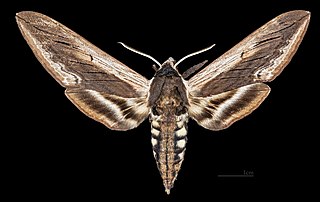
Sphinx drupiferarum, the wild cherry sphinx, is a moth of the family Sphingidae. The species was first described by James Edward Smith in 1797.

Lintneria eremitus, the hermit sphinx, is a moth of the family Sphingidae. The species was first described by Jacob Hübner in 1823. It is found in the temperate areas of the eastern United States, north into southern Canada over the Great Plains. It prefers gardens and yards, but is common wherever the nectar and larval host plants are found. This moth is easily confused with the Canadian sphinx but these two moths do not typically co-occur.

Paonias excaecata, the blinded sphinx, is a moth of the family Sphingidae. The species was first described by James Edward Smith in 1797.
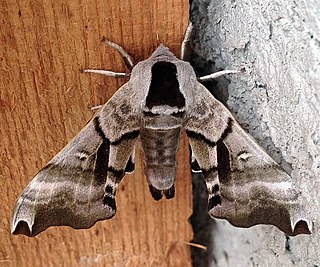
Smerinthus cerisyi, the one-eyed sphinx or Cerisy's sphinx, is a moth of the family Sphingidae. The species was first described by William Kirby who named the species in honor of Alexandre Louis Lefèbvre de Cérisy in 1837.

Psilogramma menephron, the privet hawk moth or large brown hawkmoth, is a member of the family Sphingidae. It was described by Pieter Cramer in 1780. It is usually found in Sri Lanka, India, Nepal, central and southern China, Thailand, Vietnam, Indonesia and the Philippines. Psilogramma casuarinae from eastern Australia was long treated as a synonym but is now thought to be a distinct species. The introduced population on Hawaii was first thought to be P. menephron, but is Psilogramma increta.

Amorpha juglandis, the walnut sphinx, is the only species in the monotypic moth genus Amorpha, which is in the family Sphingidae, erected by Jacob Hübner in 1809. The species was first described by James Edward Smith in 1797.

Pachysphinx modesta, the modest sphinx or poplar sphinx, is a moth of the family Sphingidae. The species was first described by Thaddeus William Harris in 1839.
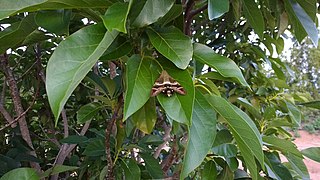
Aellopos fadus, the Fadus sphinx, is a moth of the family Sphingidae. The species was first described by Pieter Cramer in 1776.

Aellopos titan, the Titan sphinx, is a moth of the family Sphingidae. The species was first described by Pieter Cramer in 1777.

Eumorpha anchemolus, the anchemola sphinx moth, is a moth of the family Sphingidae. The species was first described by Pieter Cramer in 1780.

Eumorpha satellitia, the satellite sphinx, is a moth of the family Sphingidae. The family was first described by Carl Linnaeus in 1771. It lives from Brazil and northern Argentina north through Central America, Mexico, and the West Indies to south Texas and southern Arizona.

Eumorpha typhon, the Typhon sphinx, is a moth of the family Sphingidae. The species was first described by Johann Christoph Friedrich Klug in 1836.
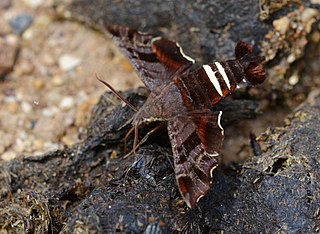
Amphion floridensis, the Nessus sphinx, is a day-flying moth of the family Sphingidae. The species was described by Pieter Cramer in 1777, and renamed in 1920. It is the only member of the genus Amphion erected by Jacob Hübner in 1819. It lives throughout the eastern United States and Canada and occasionally south into Mexico, and is one of the more commonly encountered day-flying moths in the region, easily recognized by the two bright-yellow bands across the abdomen.

Deidamia inscriptum, the lettered sphinx, is a species of moth of the family Sphingidae. It is the only member of the genus Deidamia. The species was first described by Thaddeus William Harris in 1839 and the genus was erected by James Brackenridge Clemens in 1859.
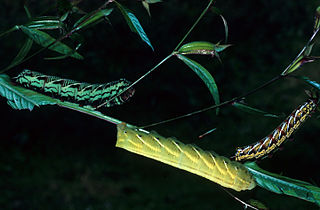
Proserpinus juanita, the Juanita sphinx, is a moth of the family Sphingidae first described by Herman Strecker in 1877. It is found from the US states of Montana and North Dakota, south to Arizona, and east to Missouri and Texas.

Sphinx kalmiae, the laurel sphinx, is a moth of the family Sphingidae.

Darapsa choerilus, the azalea sphinx, is a moth of the family Sphingidae first described by Pieter Cramer in 1779. It is found in the United States and southern Canada east of the Rocky Mountains.























